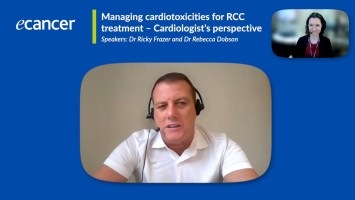We just presented it yesterday and it’s the results of our phase Ib study in ovarian cancer, platinum resistant ovarian cancer. It’s just a small cohort of patients so we reported just efficacy as well as safety data on twelve patients, six that were in a combination of paclitaxel and our drug, AVB500, and six patients who were on pegylated liposomal doxorubicin and AVB500. It’s an open label study. The purpose of this study, quite honestly, was to assess safety and tolerability and look at pharmacokinetics and pharmacodynamics because we have a biomarker that allows us to understand what the best dose is or what is the pharmacologically relevant dose for patients.
Because our drug was so benign in its safety profile we were able to test AVB500 initially in a phase I normal healthy volunteer study which is quite unusual but that study allowed us to understand what dose gave us the desired pharmacodynamic effect. That dose then we took into this phase Ib platinum resistant ovarian cancer study.
What we found at the dose we tested, 10mg/kg, was that we did meet our PK/PD objectives. The dose was safe, as we expected, no toxicities that limited dosing, no serious adverse events. We also found that we did have some responses. We actually had an overall 42% response rate with 50% response in the paclitaxel arm and 33% response in the pegylated liposomal doxorubicin arm. Small ns, early study but that was the best response in those twelve patients. When you compare to historical control, which has been fairly well established, your typical rates are 10-15%. So, while early stage, these are compelling data that make us quite excited in moving forward with the programme.
We have since announced, and we talked a little bit at the end of our presentation yesterday, Dr Monk presented it, that we’ve actually found a relationship between the patients who respond and the drug levels they get to. So the patients who get to higher drug levels are the ones that respond. The patients that don’t get to a threshold drug level that we’ve identified don’t tend to respond. In fact, 80% of the patients who get to the desired drug level will respond. So that tells us now that we should try and push to a higher dose to try and get those drug levels up higher and if our theory holds we should see greater responses in patients as long as we can get those drug levels up.
We’re amending the current phase Ib study to include a 15mg/kg dose and then a 20mg/kg dose. We will, of course, do it stepwise and have an independent data safety monitoring committee review the data prior to moving from 15mg/kg to 20mg/kg. But we’ll assess the safety, we’ll look at the PK, see if we’re getting up to those levels that we have identified as being associated with response and see if this will help us increase the response rate even to a greater extent. Because, again, if patients don’t get to that level you don’t get that response. So this will set us up nicely for the next study which, of course, we would go and chat with the FDA prior to conducting to say, ‘Here’s our exposure response.’ It’s a very nice targeted mediated drug disposition, kinetic profile, and the kinetics have held quite nicely, they’ve been linear so far. So there’s no reason to believe that going to a higher dose won’t put us up in the exposure and it might set us up nicely to talk to the FDA and say, ‘Okay, what do we do to get this on the market as quickly as possible?’ Because of the safety profile of the compound we do have that margin so we can go higher right now. So, knock on wood, that holds.


